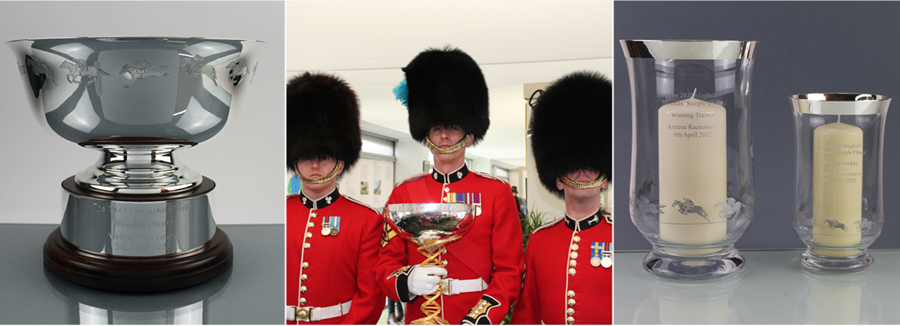The Inkerman team head to Aintree for the 15th year to provide over 70 trophies for winning owners, trainers, jockeys and stable hands. Our social media channels will be full of live updates from the trophy marquee to the winners enclosure.
Inkerman works with the very best British workshops, including silversmiths, engravers, glass etchers and leather makers to work with Inkerman designs and hand craft these beautiful bespoke pieces. The trophies are guarded by soldiers from The Royal Mercian & Lancastrian Yeomanry during the event and race-goers can see the trophies on display in the Trophy Marquee next to the parade ring throughout the meeting.
The Grand National is one of the most famous and unpredictable horse races in the world, and very definitely one of the highlights in the Inkerman calendar.
It's a hugely popular event and 600 million people watch it on TV all over the globe.
Lots of people follow it at home, and you and your family might even pick your own favourite horse - often based on its name and colours.
The race is part of a three-day race meeting held in Liverpool, with usually more than 150,000 people in attendance.
It all began at Aintree Racecourse, in Merseyside, has been the home of the famous Grand National since its first running in 1839.
A version of the race took place before this, but 1839 is accepted as the official start of the race as we know it today.
Between 1916-1918 during World War One, the race had to be moved to Gatwick Racecourse. Then, it was called off between 1941-1945 because of the Second World War.
The race has changed a lot since it began.
The courses and fences have been tweaked over the years - not least to make them safer for the horses and jockeys. The starting line has also moved further away from the main stand to help the horses to remain calmer at the beginning.
But throughout the years, it has always been one of the biggest jump races for horses and riders in the world - and it is currently the longest race in the UK.
The Course - The Grand National is held at Aintree Racecourse in Merseyside
The fences are different widths and heights, and some of them have different names
One of the most famous fences is called The Chair, which is the tallest on the course at 5 foot 3 inches.
The ground on the landing side is higher than the side the horses take off from, and there's also a six-foot ditch that horses have to jump over before the fence.
Fortunately, The Chair is one of the two fences that riders only have to go over once, rather than twice like most of the others.
Canal Turn and Becher's Brook are two other extremely difficult fences.
Red Rum died in 1995 at the age of 30 and was buried near the winning post at Aintree.
In 1993, no one won because there was a false start - some riders didn't realise and carried on so the race had to be cancelled!
George Stevens is the most successful jockey in Grand National history.
He has won the Grand National five times, but given that his final victory came back in 1870, you probably weren't around to remember this!
The fastest time ever the course has ever been completed in was by Mr Frisk in 1990, who covered the four miles and 514 yards of the race in just 8 mins 47.8 secs.
Inkerman are now in their 14th year of working with Aintree as the official trophy supplier and never before has it been run in its history behind closed doors. Inkerman are providing over 80 trophies for owners, trainers, trainers and stable hands.
The crowds and soldiers were really missed last year the Grand National 'roar' from the crowd, will be bigger and better than ever!
"The race that the world stops to watch" Sir A P McCoy
https://www.thejockeyclub.co.uk/aintree/events-tickets/grand-national/










































